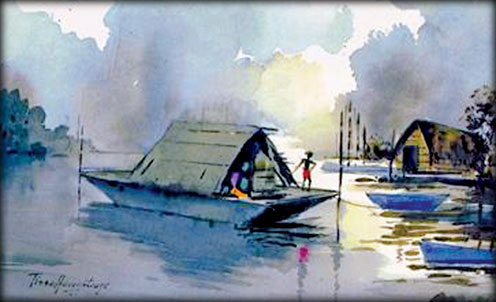Landscape with reflection on the water
by Tissa Hewavitharana
To become a skilled watercolour artist takes years of practice.
However, starting from a few basic notions it is possible to paint
acceptable landscapes. We have come across some of the most common
elements of landscapes, the majority of which, like creating skies and
trees in the distance can be applied in general landscapes.
Painting reflections is naturally a part of river scenes and sea
views. To get a good result it is necessary to bear in mind that the
reflections painted in watercolours depends fund a mentally on two
things. The background of the composition and the dark colour that is
used for reflection.
The majority of the techniques are necessary to paint a river scene,
the flow of the water, the ripples, trees in the background and
vegetation in the distance and sky. The colours have to be chosen
carefully and the brush strokes have to be long and continuous so as not
to make breaks in the superimposition.
 |
|
A watercolour painting
of a landscape |
Once the trees and shore have been painted in the area where the
water is painted, make some horizontal brush strokes with the colour
used for the trees. To finish the reflections the background should be
kept totally dry. The contrasts have to be once indicated in a darker
tone. The dark brush strokes have a space between each one so that the
foreground colour can show through.
Precise strokes
The principal shapes are drawn with very precise strokes. First the
line is drawn that separates the water and the vegetation. The
background is created with gradations and merging colours with long
horizontal brush strokes. First of all the paper should be dampened.
In the lower part a pale colour is painted and before it dries a blue
gradation is painted in the upper part and the intermediate part a
somewhat darker blue tone applied.
When the background is totally dry, you can rest assured that the
painting will not retain the colours merging with each other. At the
outset the trees can be painted in several phases. First a clear wash is
applied in a uniform manner and then the background of the trees is
painted.
After, in a medium tone some areas are shaded with vertical
brushstrokes. The river bank is painted with dry pasture using a mixture
of ochre and luminous green, in long brush strokes. Above the line of
the river bank a thin pale orange stroke is drawn. Following the process
the reflection in the water can be painted. The light wash that was done
at the beginning presents a soft gradation into the white of the paper.
The reflection on the water must be similar in size to the trees that
make it, for they are at the water's edge. If they were further away the
reflection would be smaller. Observe the river scene I have done. It was
painted on a cloudy day by the Kelani river.
Rain
Notice the dark shady clouds and the atmospheric affect of mist
expressed to show a downfall of rain at any moment. The boat is the
centre of attraction in relation to their surroundings gives a dramatic
impression of the sheer scale and grandeur of the natural world. Notice
the man standing on the edge of the boat. When you are painting figures
in a landscape it is not necessary or desirable to make them highly
detailed.
You will observe that the whole painting does not express any details
including the distance hut in this painting. Reflections express the
smooth glassiness of the water through the use of light and dark tones.
Some of the painting problems one would experience in watercolour are
streaks and runs forming the watercolour washes for example painting the
sky water reflections in water shadows and proper use of colour mixture.
It is always good to try out different drawing papers and test how
they respond to wet washes. Different papers behave in different ways,
depending on what materials they are made of and their surface coating.
The reflection area of the boat is finished off with sweeping brush
strokes. Blue and green are used in such a way that they do not blot out
the luminous tones that are the base. Finally, the near foreground can
be finished with several brush strokes in blue that merge into the
brownish grey strokes on the right.
There are four ways to apply paint to the paper. Wet on dry, dry on
dry, dry on wet and wet on wet. Generally, you should aim to include at
least two different kinds of brush strokes in painting to give it
variety.
Not only must we learn the four techniques of applying the paint to
the paper, also we must learn how to look at things with a seeing eye.
It will not guarantee you instant results. Constant practice is the only
way to get good results. |

